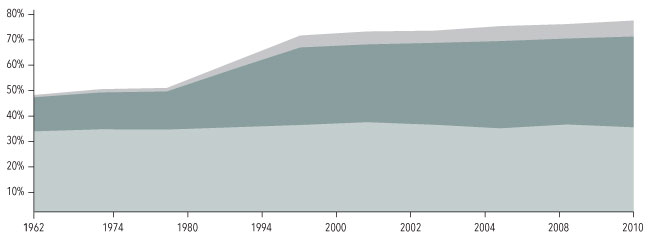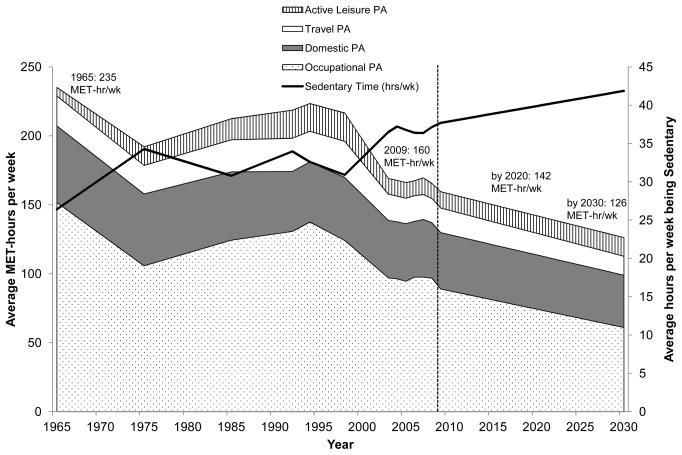

And then it stabilized, but at the higher percentages. The percentages have remained much the same, with a slight drifting upwards.
Over the last few posts we’ve looked at a few plausible culprits in this scenario, things that were introduced in the mid-70s and saturated the available market in the mid-90s, with no decline in use after that.
The first post covered changes in food availability (especially high fructose corn syrup); the second, antibiotics; the third, hormones and things that act like hormones.
The fourth and final category of prospective culprits is– technology, namely:
Fluorescent light bulbs
Computers
Microwave ovens
Compact fluorescent bulbs
 No mysterious radiation theories, just a matter of a product being used as intended, with possible unintended consequences.
No mysterious radiation theories, just a matter of a product being used as intended, with possible unintended consequences.
A little background here. Human beings respond to light, not just the amount of light but the color of light. Light that falls more in the blue spectrum has a tendency to interfere with the production of a hormone called melatonin, and that in turn interferes an individual’s ability to fall asleep and to sleep deeply. In turn, lack of sleep can contribute to obesity, perhaps because the body instinctively reaches for energy sources when sleep-deprived. (All-nighter = chocolate)
Incandescent bulbs give off light in the warmer range of the spectrum, while fluorescent bulbs spike in the blue and green ranges.
Blue-tinged lighting would thus be a likely candidate for contributing to the epidemic… except that the timing is off. True, modern spiral compact fluorescents were invented in 1976 by a GE engineer, at just the same time the obesity epidemic took off. But the invention was shelved for ten years. It wasn’t until the mid-80s that CFLs were distributed in any quantity, and by then the obesity epidemic was well underway.
Computers
It’s been popular to point at computers as culprits in the weight game, the theory being that time in front of a screen is time spent sitting down. And sitting down… broadens more than your perspective.
At first blush, the timing looks right– the first commercially-successful personal computers came on-line in the mid-1970s, beginning with the Altair 8800. That was followed quickly by the first Apple machines, the Commodore, the TRS-80, and then a multitude of new entrants into the field. But personal computers didn’t really take off until about 1980, and didn’t reach a 70% market saturation point until the mid 2000s.
 Moreover, if you compare overall physical activity charts to charts of weight gain in the U.S., a surprise awaits you. From 1975 to 1995, the period during which obesity accelerated the most rapidly, physical activity in the U.S. population actually increased:
Moreover, if you compare overall physical activity charts to charts of weight gain in the U.S., a surprise awaits you. From 1975 to 1995, the period during which obesity accelerated the most rapidly, physical activity in the U.S. population actually increased:
In 1995 it plummeted again, but the fact remains– sedentary time didn’t spike abruptly from 1975 to 1995 as obesity did.
So what remains?
Microwave ovens?
What have they got to do with anything? A lot, actually. but it has nothing to do with the microwaves themselves. Those are, as far as we know, safely contained in their sleek magic boxes. Rather, it’s the actual use of the oven that’s the problem.
As with HFCS, microwave ownership closely tracks the obesity epidemic curve. Ownership took off in the late 1970s. By 1986, 1 in 4 US households owned a microwave oven. By 1997, The U.S. Bureau of Labor Statistics reported that a staggering 9 out of 10 American households owned a microwave oven. And then… it leveled off, just as obesity did.
Cooking by conventional methods involves a lot of standing and walking, sink to stove to refrigerator and back. Over time, preparation of those daily meals adds up to a fair amount of exercise.
Moreover, conventional cooking takes time, and most cooks sample a bit as they get a meal ready. This gradual introduction of calories into the system blunts the appetite just enough to reduce consumption at the meal itself.
And, of course, pre-packaged meals come in standard sizes, almost ensuring that the entire meal will be eaten. With conventional preparation, an individual may serve themselves smaller portions. The same logic applies to restaurant meals and fast food. It comes pre-plated, and portion sizes have increased dramatically over the last few decades.
And perhaps most importantly, food preparation without the advantage of pre-prepared food and microwave ovens was simply a lot of work. It was an investment of time and energy, so people thought twice about cooking a pizza or popping a bowl of popcorn to stave off the munchies. Nowadays it’s no trouble at all… until you step on the scale.
More food = more weight. It’s just that simple.
So assuming we have uncovered at least some of the contributing factors, what do we do now? The last post injects a ray of hope.
